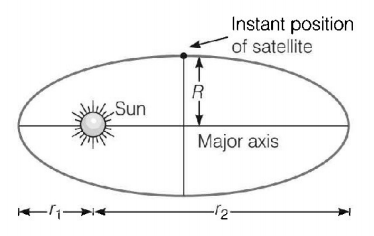Question
The largest and the shortest distance of the earth from the sun are $${r_1}$$ and $${r_2}.$$ Its distance from the sun when it is perpendicular to the major axis of the orbit drawn from the sun
A.
$$\frac{{{r_1} + {r_2}}}{4}$$
B.
$$\frac{{{r_1} + {r_2}}}{{{r_1} - {r_2}}}$$
C.
$$\frac{{2{r_1}{r_2}}}{{{r_1} + {r_2}}}$$
D.
$$\frac{{{r_1} + {r_2}}}{3}$$
Answer :
$$\frac{{2{r_1}{r_2}}}{{{r_1} + {r_2}}}$$
Solution :
From the property of ellipse, $$\frac{2}{R} = \frac{1}{{{r_1}}} + \frac{1}{{{r_2}}}$$

$$\eqalign{ & {\text{or}}\,\,\frac{2}{R} = \frac{{{r_1} + {r_2}}}{{{r_1}{r_2}}} \cr & \Rightarrow R = \frac{{2{r_1}{r_2}}}{{{r_1} + {r_2}}} \cr} $$
From the property of ellipse, $$\frac{2}{R} = \frac{1}{{{r_1}}} + \frac{1}{{{r_2}}}$$

$$\eqalign{ & {\text{or}}\,\,\frac{2}{R} = \frac{{{r_1} + {r_2}}}{{{r_1}{r_2}}} \cr & \Rightarrow R = \frac{{2{r_1}{r_2}}}{{{r_1} + {r_2}}} \cr} $$